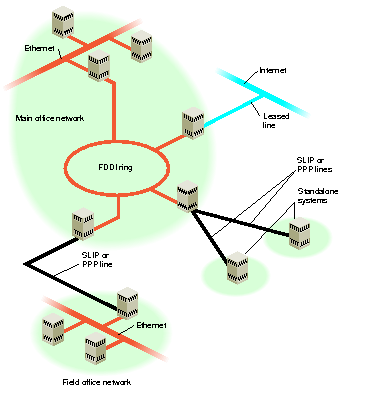Next | Prev | Up | Top | Contents | Index
Wide Area Networks
In addition to the many options available for constructing local area networks, there are several different ways of connecting local area networks into wide area networks. These systems can be used to tie together local area networks at different locations, to allow users working at scattered locations to access a network, and to connect your network to the outside world. Figure 2-1 shows how different kinds of wide-area connections might fit into a large heterogeneous network.
Two of the available systems, Serial Line Internet Protocol (SLIP) and Point-to-Point Protocol (PPP), provide a way of transferring Internet Protocol (IP) packets over a serial telephone line; this means that SLIP and PPP users can access network resources much as it they were on the local area network. PPP can also be used with Integrated Services Digital Network (ISDN). ISDN uses a high-speed digital telephone line to achieve higher throughput than a modem connection.
Another system, UNIX to UNIX Copy Program (UUCP) is an older system, primarily designed for transferring information (such as network news and electronic mail) in batch mode over serial lines.
Higher-performance network connections can be made using specialized hardware. These connections are usually over dedicated lines, leased from a telephone company, or over the telephone company's packet-switched network.

Figure 2-1 : Heterogeneous Network With Wide-Area Connections
Serial Line Internet Protocol (SLIP)
SLIP provides simultaneous operation of multiple processes on a serial cable or telephone line. It allows network users the freedom to use TCP/IP based applications over a serial cable or modem connection.
You might consider setting up a SLIP network when cost and distance are large factors in your network planning.
Point to Point Protocol (PPP)
The Point to Point Protocol is similar in nature to SLIP. PPP provides a network connection as if your system were connected to the remote host by a LAN connection. Multiple processes and TCP/IP based applications are supported.
UNIX to UNIX Copy Program (UUCP)
UUCP, also called the Basic Networking Utilities, is a set of utilities that lets stations using a version of the UNIX operating system (such as IRIX) communicate with each other over serial lines. The utilities provided range from those used to copy files between computers to those used for remote login and command execution.
You may consider setting up UUCP for long-haul communications using modems and telephone lines. It is usually used to distribute electronic mail and network news.
Integrated Services Digital Network (ISDN)
ISDN is a system that connects systems using high-speed digital telephone lines. ISDN can achieve throughput up to 128 Kb per second, several times faster than normal modem connections. However, ISDN service can be expensive, and is not available in all areas. See the ISDN User's Guide for more information on ISDN.
High Performance Wide Area Networks
If you need higher performance than you can get using SLIP or PPP over a modem link or ISDN, there are several choices available to you. The choices include Frame Relay networking and leased line service, from 56K (56 Kb per second) to T1 (1.5 Mb per second) and T3 (up to 45 Mb per second). If you require this kind of service, you'll have to shop around, comparing the prices and services offered by local Internet service providers.
Next | Prev | Up | Top | Contents | Index

